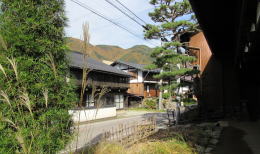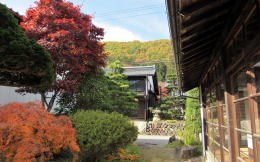◆Landform Change of Kaido◆

▲Entrance of Historic Road Museum

▲Display wears and goods to carry for trip
The landform of Wada has changed largely since Meiji until Showa period. They reclaimed the ravine of Oikawa river and digged down the ground of Nakasendo to make the road surface flatter. ⇒Explanation
Since Meiji until now the road administration of Japan has changed the landform to make car traffic efficient.
◆From Oikawabashi to Shimomachi◆
Walking from Oikawabashi to Shimomachi, you wouls find the ground of Kawachiya which is on the riverside is lower by 0.8 meter than Yamakiya which is 20 meters away from it. The house of Kawachiya is now Historic Road Museum.
Yamakiya and Kurokiya standing across the rad was a famous wholesale shop of timber. It supplied timber for building in Edo under the order of Shogunate government and clans.

▲Court of Kurokiya

▲View of mud-walled warehouse of Kokuya from Kurokiya's court
Kurokiya was a big inn. Until some decades ago its house had been out of service and devatated but was recently restored. Its architectural style looks very graceful. It has a court is still beautiful, thourgh slightly wasted.
Would you like to see the town-houses across the road. The nearer one is Shimono-Kokuya whose traditional structures has been kept well.
The house next to it, putting a garden between them, is Takagi which was once also a big inn.

▲View across the road from Kurokiya's front garden

▲On Kurokiya's yard
The structure of the its house looks graceful and grand.
It is standing on the heigher site-ground by 30-50 centimeters than the road. The height-gap, sustained with stone-wall, shows the depth made by digging down the road-ground.
A path toward Shinteiji temple runs on south side of Takagi. Then we can lseet the temple and the mountain behind it.
We would find a large town-house of the traditional structure facing the gate of Honjin across Kaido.
Considering its site position, I noticed it was holded by the highest rank family of the town. It was the house of the Hatas who was nominated for Wakihonjin and mayor. Now it was Soba-restaurant Tokuda.
By the way it has been said that the Hatas' ancester came from Chine or Korea in the ancient days. I suppose they were a fraction of Chin clan who refuged from there to Japan. In Japanese one of the letters pronounced Hata is 秦. It was a name of famous dynasty in ancuebt China.
Some villages with an advanced culture was build to be a key town of Tosando to developed agriculture and weaving-fabric manufacture in the ancient days. I suppose it was because the immgrants from the east asian continant brought with them technologies of agriculture, irrigation construction and fabric manufacture here.
The main house of Honjin which was rebuilt recently, is the most graceful and grand, to speak about the most notable town-house. Its architectureal style in Edo period was perefctly reproduced.
I will report about it on the next page. Though it is rebuilt one, it is a very rare and precious case that the main house of Honjin exists thoroughly on such a scale.
|
